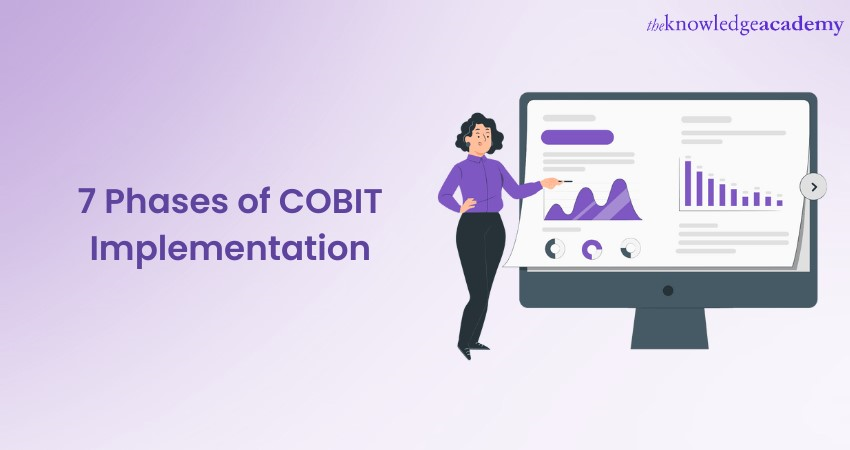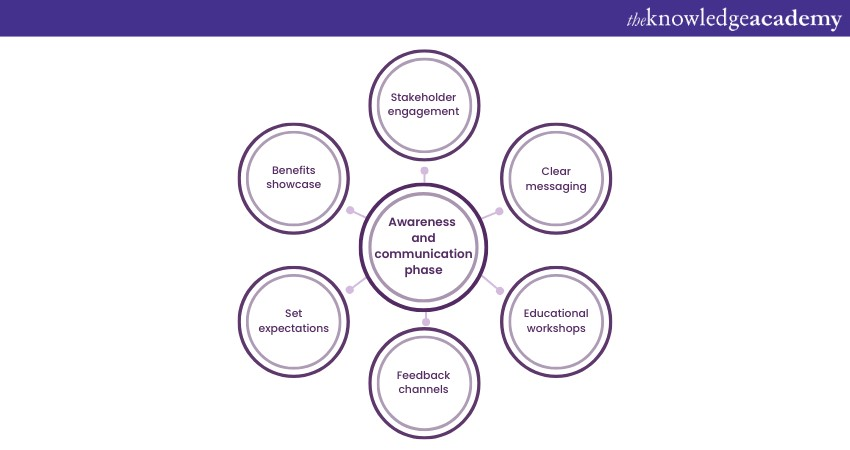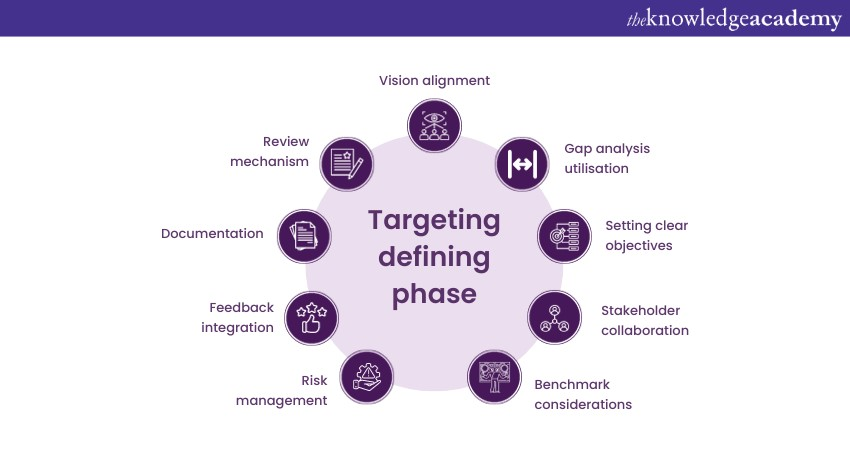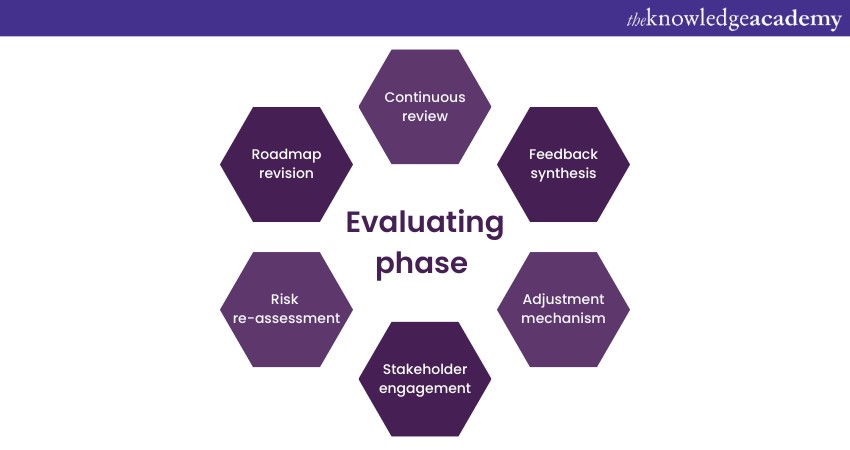We may not have the course you’re looking for. If you enquire or give us a call on +44 1344 203999 and speak to our training experts, we may still be able to help with your training requirements.
Training Outcomes Within Your Budget!
We ensure quality, budget-alignment, and timely delivery by our expert instructors.

Control Objectives for Information and Related Technologies (COBIT) offers a structured framework for organisations to develop, monitor, and enhance their IT Governance. So, if you are working in the Information Technology (IT) industry or planning to step into it, you must learn about COBIT Implementation.
COBIT implementation provides an organised approach to improving IT Governance and Management. From individuals new to COBIT to professionals looking to revamp their current processes, understanding its phases is crucial.
Want to know why is it important and how can it help in developing better Information Technology (IT) governance? Read this blog to learn about COBIT Implementation, its seven phases and how it impacts business. Read further to know more!
Table of Contents
1) What is COBIT Implementation?
2) Understanding the phases of COBIT Implementation
a) Phase 1: Awareness and communication
b) Phase 2: Establishing a baseline
c) Phase 3: Diagnostic assessment
d) Phase 4: Defining the target capability
e) Phase 5: Implementation planning
f) Phase 6: Execution and monitoring
g) Phase 7: Evaluating and adjusting
3) Conclusion
What is COBIT Implementation?
COBIT Implementation refers to the process of adopting and integrating its framework into an organisation's IT Governance and Management practices. COBIT, developed by the Information Systems Audit and Control Association (ISACA), it provides a comprehensive model designed to deliver value to the enterprise, protect its assets, and meet stakeholder needs by aligning business and IT goals.
This journey encompasses understanding the existing IT landscape, identifying areas of improvement, and leveraging COBIT's principles and practices to achieve a standardised and optimised IT environment. As organisations face increasing complexities in their digital infrastructure, coupled with evolving regulatory demands, COBIT Implementation addresses these challenges.
Unlock superior IT Governance – Register now for our COBIT® Training .
Understanding the phases of COBIT Implementation
To understand more about COBIT Implementation, let's have a detailed look at all the seven phases involved. They are as follows:
Phase 1: Awareness and communication
The initial phase of COBIT Implementation aims to introduce its principles and significance to the organisation. The goal here is to ensure everyone understands its value and role in IT Governance and Management. Organisations can take the following steps to spread awareness about the principles of COBIT:

1) Stakeholder engagement: Identify and engage key stakeholders, including management, IT personnel, and other relevant departments. Their buy-in is crucial for the successful adoption of the framework.
2) Clear messaging: Develop clear and concise messaging about what COBIT is, and its benefits, and how its implementation will affect existing processes.
3) Educational workshops: Organise workshops and training sessions to delve deeper into COBIT's principles, objectives, and practices.
4) Feedback channels: Establish open channels for feedback to understand concerns, answer queries, and address misconceptions early on.
5) Align with organisational goals: Showcase how COBIT's Implementation aligns with the broader business objectives. Moreover, emphasise the potential improvements in efficiency, risk management, and regulatory compliance.
6) Set expectations: Clarify the expected changes, challenges, and the overarching journey of COBIT Implementation.
7) Benefits showcase: Highlight case studies or examples, if available, to demonstrate tangible benefits other organisations have achieved through COBIT.
8) Continuous engagement: Ensure that awareness and communication are not one-off activities. Maintain regular updates and engagement sessions throughout the process.
9) Feedback implementation: Use the feedback gathered to refine the communication strategy. It ensures that the awareness phase evolves based on the organisation's needs and feedback.
Phase 2: Establishing a baseline
This phase emphasises understanding the organisation's current IT Governance and Management practices. It also serves as a starting point for COBIT Implementation, ensuring targeted improvements. Organisations can follow these steps to identify business goals:
1) Current state analysis: Begin by assessing the present IT processes, frameworks, and methodologies employed within the organisation. This includes evaluating current workflows, resource allocations, and software tools in use.
2) Gap identification: Using the COBIT framework as a benchmark, pinpoint areas where the organisation's existing practices diverge from COBIT recommendations.
3) Documentation: Document current operations meticulously. This includes process diagrams, responsibilities, software inventory, data flows, and other relevant IT aspects.
4) Stakeholder interviews: Engage with key personnel across departments to gain insights into existing challenges, pain points, and areas of satisfaction regarding IT practices.
5) Benchmarking: Compare the organisation's current practices with industry standards and peers to gauge where it stands.
6) Risk evaluation: Identify potential risks in the existing setup, which can be addressed using COBIT's recommendations.
7) Report compilation: Compile a comprehensive baseline report detailing the findings, gap analyses, and risks identified.
8) Feedback mechanism: Once the baseline is established, seek feedback from relevant stakeholders to validate the findings.
9) Foundation for future steps: The established baseline now acts as a reference point, guiding the subsequent phases of COBIT Implementation. This ensures targeted and impactful changes.

Phase 3: Diagnostic assessment
This phase of COBIT Implementation aims to comprehensively diagnose the efficiency and effectiveness of current IT processes. It also aims to identify areas that require immediate attention. Let's see what steps are taken:
1) Advanced gap analysis: While the baseline establishes where the gaps are, the diagnostic assessment explores why those gaps exist. It focuses on root causes rather than just symptoms.
2) Tool utilisation: Leverage specialised diagnostic tools, software, or third-party services to analyse processes in-depth. This can provide insights that might be overlooked in manual evaluations.
3) Focused stakeholder interactions: Engage in more specific conversations with stakeholders, seeking insights on identified gaps, potential remedies, and their perceived implications.
4) Prioritisation: Based on findings, prioritise areas that require immediate intervention, weighing the potential benefits against the challenges.
5) Risk depth analysis: Explore the potential impacts of the risks and the feasibility of mitigation using COBIT recommendations.
6) Performance metrics: Identify and measure current performance metrics, establishing a clearer understanding of where the inefficiencies lie.
7) Recommendation drafting: Develop an initial set of recommendations based on diagnostic findings to address the identified gaps and inefficiencies.
8) Feedback loop: Continue to gather feedback, ensuring that the diagnostic findings resonate with the experiences of those engaged in daily IT operations.
9) Setting the stage: The diagnostic assessment sets the stage for actionable steps in the subsequent COBIT Implementation phases. It ensures that the organisation moves forward with a clear direction and purpose.
Phase 4: Defining the target capability
This phase of COBIT Implementation revolves around setting clear, measurable, and achievable targets for the organisation's IT Governance and Management. These are in line with COBIT's standards and the business's overarching goals. Let's look at the various steps undertaken during this phase:

Vision alignment: Ensure that the defined capabilities align with the organisation's long-term vision and objectives. This helps foster synergy between IT operations and business strategy.
Utilisation of gap analysis: Use insights from the previous phases, especially the diagnostic assessment, to define areas requiring significant improvement or transformation.
Setting clear objectives: Define specific objectives for each identified area, ensuring they are Specific, Measurable, Achievable, Relevant, and Time-bound (SMART).
Stakeholder collaboration: Collaborate with key stakeholders to gain insights and validation on the defined targets. This ensures that your objectives resonate with the actual needs of the organisation.
Benchmark considerations: Take industry standards, peer performance, and best practices into account when setting target capabilities.
Risk management: Incorporate strategies to manage and mitigate potential risks associated with transitioning to the desired capabilities.
Feedback integration: Integrate feedback and insights from the diagnostic assessment to refine and enhance the target capabilities.
Documentation: Document the defined target capabilities meticulously, ensuring they serve as a clear reference for the forthcoming phases.
Review mechanism: Establish a mechanism for periodic review of the set targets, ensuring they remain relevant and adaptive to changing organisational needs and external factors.
Phase 5: Implementation planning
This is the primary COBIT Implementation phase, which includes planning and revolves around translating the defined target capabilities into a structured and actionable plan. Here, teams ensure that they adhere to a systematic approach to achieving COBIT's objectives within the organisation. The following are some of the steps taken during phase 5:
1) Roadmap development: Design a comprehensive roadmap that outlines the step-by-step process of integrating COBIT Implementation practices, specifying milestones, timelines, and resource allocations.
2) Stakeholder alignment: Engage key stakeholders to align on the plan, ensuring collective buy-in and addressing any concerns proactively.
3) Resource allocation: Determine the necessary resources such as manpower, technology, or finances. Also, ensure they're appropriately marked for each phase.
4) Risk management strategy: Identify potential challenges or risks associated with the plan and develop mitigation strategies to address them.
5) Communication plan: Develop a clear communication strategy to keep all involved parties informed about the progress, challenges, and achievements throughout the phases.
6) Training and development: Identify areas where staff training might be required and schedule sessions to ensure they're equipped with the necessary knowledge and skills for COBIT integration.
7) Dependencies analysis: Assess and document any dependencies that could influence the process, ensuring a holistic approach to planning.
8) Monitoring mechanisms: Establish checkpoints and review mechanisms within the plan to ensure the organisation stays on course.
9) Feedback integration: Incorporate a mechanism to integrate feedback continuously. This can allow the plan to evolve and adapt to unforeseen challenges or changes.
Phase 6: Execution and monitoring
This critical phase of COBIT Implementation means that the defined target capabilities are implemented. They should also constantly monitor them for adherence, efficiency, and desired outcomes. Here are some of the steps to take during this phase:
1) Actionable steps: Initiate specific actions, interventions, and process redesigns based on the objectives set in the previous phases.
2) Change management: Recognise that this phase may involve considerable change. Implement strategies to manage resistance, ensure smooth transitions, and foster acceptance among stakeholders.
3) Monitoring tools: Utilise tools and software solutions to examine and evaluate the effectiveness of the implemented changes in real time.
4) Feedback mechanism: Establish a robust feedback system, gathering inputs from IT personnel, stakeholders, and end-users to gauge the efficacy of the changes.
5) Performance metrics: Regularly assess and measure performance against the set metrics from the target capability phase. This can ensure alignment and identification of areas of deviation.
6) Iterative improvement: Based on monitoring results, make necessary adjustments. Remember, the COBIT journey is iterative, and continuous improvement is key.
7) Risk oversight: Continuously oversee potential risks, ensuring that they're effectively managed and that mitigation strategies are in place.
8) Stakeholder communication: Maintain open channels of communication, updating stakeholders on progress, challenges, and successes.
9) Review checkpoints: Set up regular checkpoints to review progress and assess if the organisation is on track to achieve its target capabilities within set timelines.
Phase 7: Evaluating and adjusting
Phase 7 underscores the need for a continuous evaluation of the implemented changes. Here, the teams ensure that the organisation remains aligned with its target capabilities. This phase is also responsible for making necessary adjustments as required. Let's look at the key actions taken during this phase:

1) Continuous review: Regularly review and evaluate the outcomes of the execution phase against set targets, identifying any areas of divergence.
2) Feedback synthesis: Collaborate and analyse feedback from various stakeholders. Utilise this feedback to gain a deeper understanding of the system's effectiveness and areas of potential enhancement.
3) Adjustment mechanism: Based on the evaluations, make targeted adjustments to realign processes, tools, or practices that might have veered off course.
4) Performance metrics re-evaluation: Revisit and, if necessary, refine the performance metrics to ensure they are still relevant and capture the desired outcomes accurately.
5) Stakeholder engagement: Engage with stakeholders to communicate findings, adjustments, and the rationale behind them, fostering transparency and trust.
6) Lessons learned: Document insights and lessons gleaned from the evaluation, aiding future initiatives and phases of COBIT Implementation.
7) Risk re-assessment: Re-assess any emerging or existing risks in the light of adjustments, updating mitigation strategies accordingly.
8) Iterative approach: Emphasise the iterative nature of the COBIT framework, reinforcing the idea that evaluation and adjustment are ongoing necessities.
9) Roadmap revision: Based on evaluations, revise the COBIT Implementation roadmap for future phases or strategies. This can ensure the organisation stays adaptive and future-ready.
Conclusion
Incorporating COBIT Implementation into an organisation's framework requires strategic planning and iterative evaluation. By understanding and methodically progressing through each phase, from awareness to evaluation, they can optimise their IT Governance. They also can ensure alignment with business objectives and foster operational excellence.
Begin your journey to IT Governance mastery – Register now for our COBIT® Foundation Course.







 Top Rated Course
Top Rated Course



 If you wish to make any changes to your course, please
If you wish to make any changes to your course, please


